Social housing dwellings
There are four main social housing programs funded by governments and provided by both government and non-government organisations in Australia. These social housing rental programs include public housing, mainstream community housing, state owned and managed Indigenous housing (SOMIH), and Indigenous community housing.
Quick facts
- At 30 June 2017, there were around 435,700 social housing dwellings—a rise of almost 3,000 dwellings (<1%) over the past 12 months, and an increase of 5.4% from 413,200 dwellings in 2008–09.
- The number of dwellings in mainstream community housing more than doubled between 2008–09 and 2016–17 (from 39,800 to 82,900 dwellings). This has been offset by a decrease of dwellings in public housing (from 336,500 to 319,900) over the same 9-year period.
- Despite growth in the number of social housing dwellings, this stock has not kept pace with overall household growth—social housing share fell from 5.1 per 100 households in 2007–08 to 4.6 in 2016–17.
- At 30 June 2017, New South Wales had the largest number of social housing dwellings across each program type, with the exception of Indigenous community housing, where Queensland had the most.
- The greatest proportion of social housing dwellings were in the form of a separate, 3-bedroom house. This has been consistent over time.
Over time, there has been a gradual but steady policy focus towards growing the community housing sector and transferring ownership or management of public housing stock to community housing organisations. This has provided community organisations an opportunity to expand their operational capacity and to demonstrate the ability to be flexible in their delivery of social housing.
Number of dwellings
For the purpose of this report, a dwelling is defined as a structure, or a discrete space within a structure, intended for a person or group of people to live. Dwelling types may include:
- a separate house,
- a semi-detached, row or terrace house, townhouse, etc.,
- a flat, unit or apartment; caravan, tent, cabin etc.
Between 2008–09 and 2016–17, there has been a 5% decrease of dwellings in public housing, from 336,500 to 319,900. This has been offset by an increase in the number of dwellings in mainstream community housing (from 39,800 to 82,900 dwellings) over the same 9-year period (Figure 4.1).
Figure 4.1: Number of social housing dwellings, 2009 to 2017
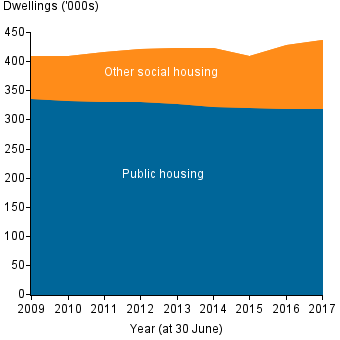
Note: ‘Other social housing’ refers to SOMIH, mainstream community housing and Indigenous community housing.
Source: AIHW National Housing Assistance Data Repository. Northern Territory Government. Department of Housing, Annual Report. Darwin, NT. See supplementary table DWELLINGS.1.
At 30 June 2017, there were around 435,700 dwellings in social housing in Australia. Of these dwellings, 73% were in public housing; 3% were in SOMIH; 19% were in mainstream community housing; and 4% were in ICH.
Over the past 12 months, the number of public housing dwellings has decreased slightly continuing the trend of falling public rental housing numbers. ICH dwelling numbers, while remaining relatively steady over the past 12 months, have also fallen between 2009–10 and 2016–17, from 18,700 to 17,900 (a fall of 4%) (Figure 4.2).
In contrast, in the past 12 months mainstream community housing numbers have increased by 3%, and between 2008–09 and 2016–17, the number of mainstream community housing dwellings has more than doubled (from 39,800 to 82,900 (a rise of 108%)).
SOMIH dwelling numbers decreased by 17% between 2008–09 and 2015–16, but increased between 2015–16 and 2016–17, from 9,900 to 14,900 (a rise of 50%). This is primarily due to the reporting of NT remote public housing through the SOMIH collection.
Figure 4.2: Number of social housing dwellings, by social housing program type (excluding public housing), 2009 to 2017
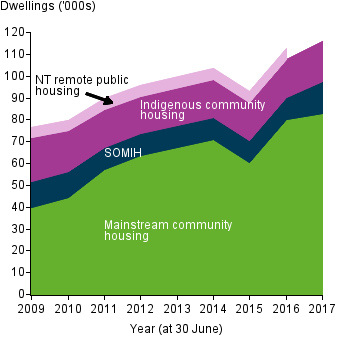
Note: Data relating to NT remote public housing dwellings (including town camp dwellings) have been reported for the first time in the 2016–17 SOMIH collection. Previously, these dwellings have been reported separately.
Source: AIHW National Housing Assistance Data Repository. Northern Territory Government. Department of Housing, Annual Report. Darwin, NT. See supplementary table DWELLINGS.1.
Location
At 30 June 2017, New South Wales had the largest number of social housing dwellings across each program type, except for Indigenous community housing, which had more dwellings reported in Queensland. Victoria had the next highest number of dwellings for public housing and mainstream community housing (See supplementary table DWELLINGS.3).
The social housing profiles in each jurisdiction are distinct, reflecting the shift in policy focus to enable flexibility in the delivery of social housing, to better meet the needs of their inhabitants (Table 4.1). For example, while the five largest states (NSW, Vic, Qld, WA and SA) have broadly similar profiles, with the majority consisting of public housing (71–80%) followed by mainstream community housing (16–22%), Tasmania and the Northern Territory display greater program diversity.
| Social housing program | NSW | Vic | Qld | WA | SA | Tas | ACT | NT | Aust. |
|---|---|---|---|---|---|---|---|---|---|
|
Dwellings (Number) |
|||||||||
|
Public housing |
110,221 |
64,170 |
51,263 |
33,836 |
37,281 |
7,065 |
11,077 |
5,000 |
319,913 |
|
SOMIH(a) |
4,608 |
. . |
3,324 |
. . |
1,734 |
223 |
. . |
5,032 |
14,921 |
|
Mainstream community housing(b) |
34,398 |
14,278 |
11,512 |
7,847 |
7,484 |
6,115 |
883 |
385 |
82,902 |
|
Indigenous community housing(b)(c)(d) |
5,066 |
1,720 |
5,232 |
2,649 |
934 |
76 |
. . |
2,248 |
17,925 |
|
All programs |
154,293 |
80,168 |
71,331 |
44,332 |
47,433 |
13,479 |
11,960 |
12,665 |
435,661 |
|
Dwellings (%) |
|||||||||
|
Public housing |
71.4 |
80.0 |
71.9 |
76.3 |
78.6 |
52.4 |
92.6 |
39.5 |
73.4 |
|
SOMIH(a) |
3.0 |
. . |
4.7 |
. . |
3.7 |
1.7 |
. . |
39.7 |
3.4 |
|
Mainstream community housing(b) |
22.3 |
17.8 |
16.1 |
17.7 |
15.8 |
45.4 |
7.4 |
3.0 |
19.0 |
|
Indigenous community housing(b)(c)(d) |
3.3 |
2.1 |
7.3 |
6.0 |
2.0 |
0.6 |
. . |
17.7 |
4.1 |
|
All programs |
100.0 |
100.0 |
100.0 |
100.0 |
100.0 |
100.0 |
100.0 |
100.0 |
100.0 |
. . not applicable
- VIC, WA, and ACT do not have SOMIH programs. Data relating to NT remote dwellings (including town camp dwellings) have been reported for the first time in the 2016–17 SOMIH collection, previously these dwellings have been reported separately.
- Community housing data are incomplete due to non-reporting or under-reporting by community housing providers. Data may not be comparable across jurisdictions due to differences in the accuracy of the data (e.g., reflecting differences in how the data for the collection was sourced by jurisdictions, the number and profiles of providers for which data were provided/not provided, the completeness of the data reported for some providers and the instances of unknown values recorded for some data items). Tenancy (rental) units in mainstream community housing are reported for mainstream community housing as these are equivalent to dwellings in other housing collections.
- Indigenous community housing data include permanent dwellings managed by funded and unfunded providers.
- ACT does not have an Indigenous Community Housing program.
Note: Some percentages may not total 100 due to rounding.
Source: AIHW National Housing Assistance Data Repository. See supplementary table DWELLINGS.3.
Proportions of social housing dwellings also varied across remoteness areas. At 30 June 2017, Major cities had the highest proportions of public housing, SOMIH and mainstream community housing dwellings (74%, 36% and 66%, respectively). As expected, the highest proportion of Indigenous community housing dwellings was in Very remote areas (48%) (Figure 4.3).
Figure 4.3: Social housing dwellings (per cent), by remoteness area and housing program type, at 30 June 2017
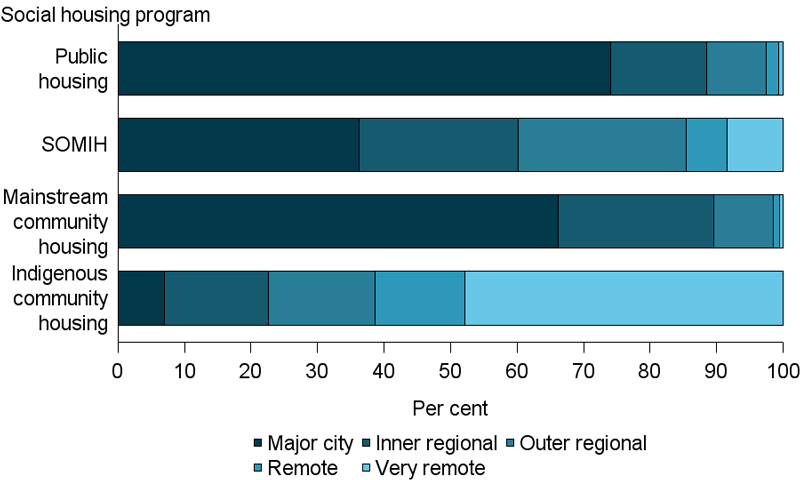
Note: Dwellings with missing location information are excluded.
Source: AIHW National Housing Assistance Data Repository. See supplementary table DWELLINGS.4.
Dwelling characteristics
At 30 June 2017, public housing dwellings were most commonly in the form of a separate house (38%), followed by a flat, unit or apartment (35%). The vast majority of SOMIH dwellings were in the form of a separate house (81%), with a further 14% being a semi-detached house or townhouse (Figure 4.4).
Unlike public rental housing and SOMIH, mainstream community housing dwellings were in the form of a flat, unit or apartment (49%), followed by a separate house (29%).
Figure 4.4: Social housing dwellings (per cent), by structure and social housing program, at 30 June 2017
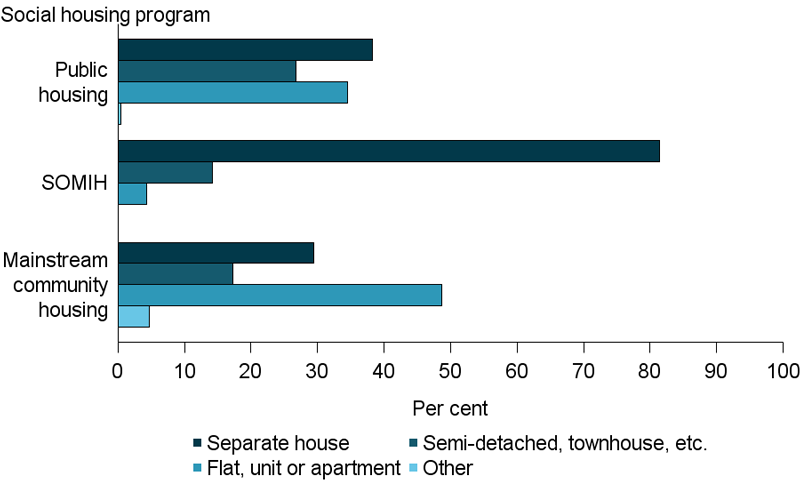
Notes
- Dwellings with missing dwelling type information are excluded.
- Excludes SOMIH data for the NT as only selected information are submitted as final aggregate data for the SOMIH data collection.
- Data for dwelling structure in Indigenous Community Housing were unavailable.
Source: AIHW National Housing Assistance Data Repository. See supplementary table DWELLINGS.5.
At 30 June 2017, the size of social housing dwellings also differed across program type. Public housing dwellings were most likely to be three bedroom dwellings (37%), followed by two bedroom dwellings (31%). The majority of SOMIH dwellings were three bedroom dwellings (61%) (Figure 4.5).
In contrast, mainstream community housing dwellings were most commonly two or one bedroom dwellings (35% and 34%, respectively). Almost half of Indigenous community housing dwellings were three bedroom dwellings (49%).
Figure 4.5 Social housing dwellings (per cent), by number of bedrooms and social housing program, at 30 June 2017
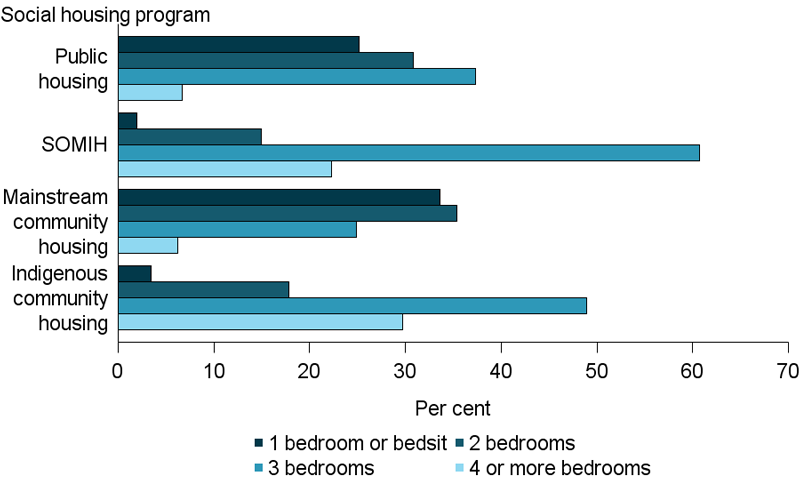
Notes
- Dwellings with missing bedroom information are excluded.
- Excludes SOMIH data for the NT as only selected information are submitted as final aggregate data for the SOMIH data collection.
Source: AIHW National Housing Assistance Data Repository. See supplementary table DWELLINGS.6.
Social housing organisations
Community housing organisations
In general, the majority of community housing (CH) organisations in all states and territories except Western Australia, were managing fewer than 50 dwellings. At 30 June 2017, Queensland had the highest number of CH organisations, at almost 200 (Table 4.2). The majority of these were CH organisations that managed fewer than 20 dwellings. New South Wales had the next highest number of CH organisations with 154. Of these, the majority were CH organisations that managed fewer than 20 dwellings. On the other hand, New South Wales also had the highest number of CH organisations that managed 200 or more dwellings (26).
| Number of dwellings(a) managed | NSW | Vic | Qld | WA | SA | Tas | ACT | NT | Total |
|---|---|---|---|---|---|---|---|---|---|
|
200 or more dwellings |
26 |
11 |
12 |
11 |
10 |
5 |
2 |
0 |
77 |
|
100–199 dwellings |
6 |
4 |
9 |
4 |
8 |
1 |
0 |
0 |
32 |
|
50–99 dwellings |
11 |
9 |
14 |
7 |
1 |
3 |
1 |
1 |
47 |
|
20–49 dwellings |
18 |
17 |
35 |
5 |
12 |
12 |
3 |
5 |
107 |
|
Less than 20 dwellings |
91 |
23 |
123 |
5 |
17 |
36 |
1 |
28 |
324 |
|
Not stated |
2 |
29 |
0 |
0 |
0 |
0 |
0 |
0 |
31 |
|
Total |
154 |
93 |
193 |
32 |
48 |
57 |
7 |
34 |
618 |
- Dwellings are defined as the unit of accommodation (a structure or a discrete space within a structure intended for people to live in or where a person or group of people live) to which a rental agreement can be made. These are known as tenancy (rental) units in mainstream community housing.
Note: Mainstream community housing organisations include not-for-profit organisations that provide safe, secure, affordable and appropriate rental housing. The information was sourced by state/territory housing authorities from community housing organisations and/or from administrative records held by them. Data are incomplete for some jurisdictions due to non-reporting or under-reporting by community housing providers. The response rate differs between jurisdictions—as outlined in the data quality statement for this collection.
Source: AIHW National Housing Assistance Data Repository. See supplementary table DWELLINGS.8.
Indigenous community housing organisations
In general, across Australia, most Indigenous community housing (ICH) organisations were managing fewer than 50 dwellings (Table 4.3). At 30 June 2017, New South Wales reported the highest number of ICH organisations, at 111. Nearly half (49%) of these organisations managed fewer than 20 dwellings.
| Number of dwellings(a) managed | NSW | Vic | Qld | WA | SA | Tas | ACT | NT | Total |
|---|---|---|---|---|---|---|---|---|---|
|
200 or more dwellings |
2 |
1 |
12 |
5 |
1 |
0 |
. . |
2 |
23 |
|
100–199 dwellings |
2 |
0 |
3 |
0 |
0 |
0 |
. . |
3 |
8 |
|
50–99 dwellings |
10 |
2 |
2 |
1 |
0 |
0 |
. . |
11 |
26 |
|
20–49 dwellings |
43 |
9 |
7 |
0 |
0 |
2 |
. . |
11 |
72 |
|
Less than 20 dwellings |
54 |
3 |
4 |
0 |
0 |
0 |
. . |
7 |
68 |
|
Total |
111 |
15 |
28 |
6 |
1 |
2 |
. . |
34 |
197 |
. . not applicable
- Dwellings are defined as the unit of accommodation (a structure or a discrete space within a structure intended for people to live in or where a person or group of people live) to which a rental agreement can be made.
Notes
- Includes funded Indigenous community housing organisations (ICHOs) (those ICHOs that received government funding in the relevant financial year). The ACT does not have an Indigenous community housing program. The information is sourced via jurisdiction administrative systems, dwelling audits conducted by states and territories and from ICHOs through data collection tools. Data are incomplete for some states and territories due to non-reporting or under-reporting by ICHOs. More information on data quality is contained in the data quality statement for this collection.
- Indigenous community housing organisations (ICHOs) include any Aboriginal and/or Torres Strait Islander organisation that is responsible for managing housing for Indigenous people. This includes community organisations such as resource agencies and land councils, which have a range of functions, provided that they manage housing for Indigenous people. Where a state or territory housing authority is responsible for managing ICH tenancies for Indigenous people, they are classified as an ICHO for reporting purposes.
Source: AIHW National Housing Assistance Data Repository. See supplementary table DWELLINGS.8.


